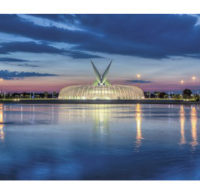Builders of a glass-sheathed Florida college building—topped by a 250-ft-long skylight shading system with 94 louvered arms that raise and lower to track the sun—say they could not have successfully executed the unusual design without intense consultant-contractor cross-pollination. The $60-million building nearing completion in Lakeland, designed by architect Santiago Calatrava, is on time and on budget thanks to the teamwork, they say.
Designed as the signature element of Florida Polytechnic University's still-emerging campus, the 162,000-sq-ft Innovation, Science and Technology Building (IST) stretched the team's envelope of experience. "Every corner we turned, there was something that required close attention," says Joey Ottman, with Alfonso Architects, the project's Tampa-based architect of record.
Construction manager Skanska USA, Tampa, is credited with breaking down traditional silos of silence between the design and construction team.
Calling it an "open, collaborative effort," Roger Webb, operations manager for Baker Concrete Construction—the specialty contractor that delivered the exposed concrete structures inside the building—says Skanska "engaged the design members into the construction process more than I've ever seen."
To that end, Skanska vice president of operations and project leader, Chuck Jablon, eschewed an emphasis on contractual responsibilities in lieu of a broader, shared approach to finding solutions to design challenges. Specialty contractors and sub-designers participated early in the project in a design-assist role.
"We worked with the architect and the consultants from conception," says Jablon, noting monthly trips by various team members to Calatrava's New York City office. "All of us were a team that worked as one."
The facility will serve as the first and central building for the campus of Florida Polytechnic University, which was created in 2012 as a new state institution—and the only one dedicated to a curriculum of science, technology, engineering and math. The two-story reinforced concrete structure—which includes labs, classrooms, offices and common areas—is surrounded by a system of 84 connected pergolas that visually enclose the terraces that encircle the building.
Skanska's contract also included construction of a 5,000-sq-ft central energy plant housing four 600-ton chillers and four cooling towers, all controlled via "cloud-based" systems.
Starting at the Top
The need for the close-knit interaction was apparent early, starting with the main challenge posed by the 3D puzzle-like design of the rooftop shading system. To control daylight entering the glass-covered structure, the architect opted for a system of louver arms as long as 62 ft that automatically raise and lower, in an arc, with the passing sun.
"The movement of the louver arms is integral to the design functionally, technologically and symbolically," says Frank Lorino, chief architect of Calatrava's New York office.
That movement is significant in other ways, too. Each louver arm is engineered with the capability of a maximum upright position equal to approximately 65˚ above the horizontal plane. In the fully lowered position, the operable louver arms will rest at 48˚ below the horizontal plane. Traveling that total 113˚ distance will take between seven and 10 minutes.
"Symbolically, the operable louvers help the building create a strong identity for the new university campus," says Lorino. Thanks to this, the team needed to be able to construct the kinetic system without evident compromise to the design concept, he adds.
The louvers, which control solar heat gain and regulate light levels, were designed to eventually accommodate a system of photovoltaic tape to generate power for the campus, says Skanska. According to architect Lorino, the IST's operable system is roughly twice the size of the one Calatrava designed for the Milwaukee Art Museum. When the louver arms are in their full upright position, the two-story Florida building measures 130 ft from bottom to top.
Originally, the architect proposed building the system as a pair of matched structural-steel components—consisting of 47 arms each—that would move separately via hydraulic equipment situated at each end. But the approach proved unfeasible because the system would have generated extreme loads on the structure, says the structural engineer.














